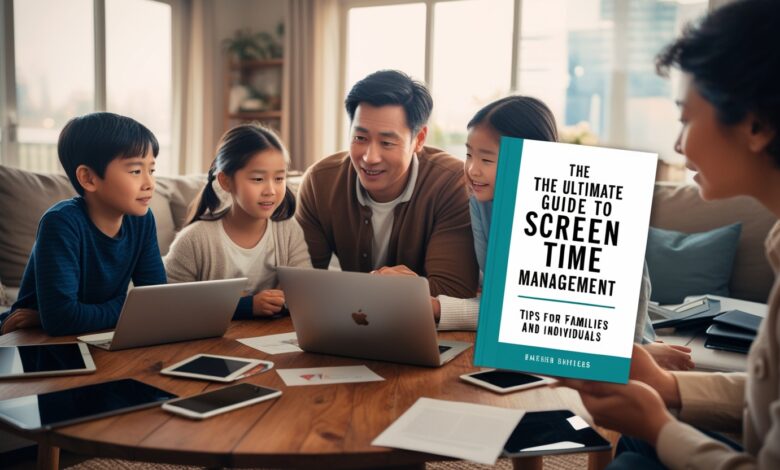The Ultimate Guide to Screen Time Management: Tips for Families and Individuals

In a world where screens dominate our daily lives, managing screen time has become more crucial than ever. Whether it’s scrolling through social media, binge-watching shows, or gaming for hours on end, excessive screen exposure can lead to various negative impacts on both physical and mental health. Families are often caught in the tug-of-war between technology’s benefits and its drawbacks.
But fear not! With intentional strategies in place, we can reclaim our time from the clutches of screens while still enjoying the digital advancements that enrich our lives. This ultimate guide will explore effective screen time management techniques tailored for families and individuals alike. Together, we’ll discover how to set healthy boundaries with technology and foster an environment where offline activities thrive alongside digital engagement. Let’s dive into a balanced approach that promotes mindfulness in this ever-connected age!
The Negative Effects of Excessive Screen Time
Excessive screen time can significantly impact physical health. Many individuals experience eye strain, headaches, and disrupted sleep patterns from prolonged exposure to screens.

Mental well-being also suffers. Continuous engagement with digital platforms often leads to anxiety and depression. The constant comparison on social media fuels feelings of inadequacy.
Social skills may decline as well. Face-to-face interactions decrease when more time is spent online instead of engaging with family or friends in real life.
Moreover, excessive screen use can hamper academic performance for children. Distractions from educational tasks lead to lower concentration levels and diminished learning outcomes.
A sedentary lifestyle becomes common among heavy screen users. This inactivity contributes to weight gain and related health issues over time.
Tips for Parents to Limit Their Children’s Screen Time
Establishing clear rules around screen use is vital. Set specific time limits for different activities, whether it’s gaming, social media or watching shows.
Create tech-free zones in your home. Areas like the dining room and bedrooms can promote healthier habits by encouraging face-to-face interaction.
Be a role model. If you demonstrate mindful screen usage, your children are more likely to follow suit. Share moments when you unplug and engage with them instead.
Involve kids in outdoor activities or hobbies that don’t involve screens. Encourage sports, arts and crafts, or family outings to foster creativity and connection.
Make tech part of conversations rather than a solitary activity. Discuss what they watch or play together to understand their interests better while guiding content choices responsibly.
Reward positive behavior regarding screen time management with privileges or fun offline experiences.
Strategies for Adults to Manage their Screen Time
Managing screen time as an adult can be a challenge. It’s essential to set clear boundaries for yourself. Start by designating specific hours for work and leisure.
Try using the Pomodoro Technique, where you focus on tasks in intervals, followed by short breaks. This helps break up prolonged periods of screen exposure.
Another effective strategy is to create tech-free zones in your home, such as the bedroom or dining area. This encourages healthier habits during personal time and meals.
Consider tracking your usage with apps that provide insights into how much time you spend on different platforms. Awareness is often the first step toward change.
Prioritize activities that don’t involve screens—reading a book or going for a walk can be refreshing alternatives that promote mindfulness and reduce digital fatigue.
Technology Tools for Screen Time Management
Managing screen time can be simplified with the right technology tools. Numerous apps are designed to help individuals and families track their usage effectively.
One popular option is “Screen Time” for iOS devices, which provides detailed insights into daily habits. Users can set limits on app usage and even schedule downtime.
For Android users, “Digital Wellbeing” offers similar features. It allows you to see how long you’ve spent on apps and set timers to encourage breaks from screens.
Parental control apps like “Qustodio” or “Net Nanny” enable parents to monitor their children’s online activities while enforcing healthy boundaries. These tools often include web filtering options as well.
Consider using browser extensions such as “StayFocusd” that limit access to distracting websites during designated work hours. They make it easier to stay productive in our hyper-connected world.
Finding a Balance: Incorporating Offline Activities
Finding a balance between screen time and offline activities is essential for well-being. Engaging in real-world experiences fosters creativity and social skills.
Start by scheduling family outings or game nights. Board games, puzzles, or outdoor sports can be exciting alternatives to screens. Nature walks not only promote physical health but also offer a serene environment to bond.
Encourage hobbies like reading, cooking, or crafting. These activities stimulate the mind and provide an excellent break from digital distractions.
Create tech-free zones at home as safe spaces for conversation and connection. Designate specific times during meals or before bed where devices are put away entirely.
Lead by example. Show enthusiasm for offline pursuits; your actions will inspire others to join you in embracing a more balanced lifestyle without screens dominating every moment.
Conclusion: The Importance of Mindful Screen Usage in Today’s Digital Age
As we navigate an increasingly digital world, the importance of mindful screen usage cannot be overstated. Our devices can provide entertainment, education, and connection, but they also pose significant challenges. A balanced approach to screen time management is essential for both families and individuals.
Being aware of the potential negative effects of excessive screen use empowers us to make informed choices. Parents play a crucial role in setting boundaries for their children while also modeling healthy habits themselves. Adults must find strategies that work amidst busy schedules and constant notifications.
Utilizing technology tools can aid in maintaining control over our screen time, offering valuable insights into our usage patterns. However, it’s equally important to prioritize offline activities that foster real-world connections and creativity.
By embracing a thoughtful stance toward screens, we can cultivate healthier relationships with technology—enhancing our lives rather than letting it dominate them. The goal is not complete disconnection but rather finding harmony between online engagement and life beyond the screens. This balance will contribute positively to mental well-being as we adapt to today’s fast-paced digital landscape.



